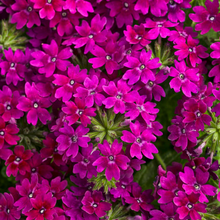DETAILS
Overview
Just call me OLD FAITHFUL.
The Royale series have an early compact habit that becomes a vigorous spreader with strong garden performance. The abundance flowering helps Royale varieties really stand out in the garden.
Superbena Royale verbenas are vigorous and mounded, but will trail over the sides of containers. They will function as both spillers and fillers in combination planters and are best planted at the front of landscape beds. Flower and umbel size are typical for verbena. They will bloom earlier in the season and more easily produceable in smaller containers than regular Superbena varieties.
They flower all season.
Superbena have an early compact habit that becomes a vigorous spreader with strong garden performance. The abundance flowering helps these varieties really stand out in the garden.
Sun Exposure

Plants that require part sun to part shade need at least 4 hours of sun but can’t take more than 6 hours of sun. These are great for locations that only get the morning sun or only get the afternoon sun or only get the evening sun. They can also be planted in area that filters the sun all day long like under a tree.
Growing Season



Dimensions
Height: 6-12”
Width: 18-24”
Spacing: 8-12”
Qualities
- Long Blooming
- Heat Tolerant
- Deadheading Not Necessary
- Thriller
- Upright
- Resists Deer
- Drought Tolerant
- Attracts Butterflies
- Attracts Hummingbirds
Maintenance Notes
Self-cleaning, no deadheading necessary.
Superbena are our most vigorous, heat tolerant, and mildew tolerant series. While always great in containers they are also fantastic in landscape beds. They can tolerate dry soils and lower fertility. Normally either an application of slow release fertilizer or amending with compost is enough to keep them happy and blooming in landscape beds. They shouldn't need to be trimmed back but can be given a "haircut" - a trim back - using a sharp pair of scissors or pruning shears at any time. While naturally well branched, trimming them back will encourage additional branching, fuller plants, and ultimately more flowers. I usually give them a very slight trim as I am transplanting to boost branching.
An application of fertilizer or compost on garden beds and regular fertilization of plants in pots will help ensure the best possible performance.




